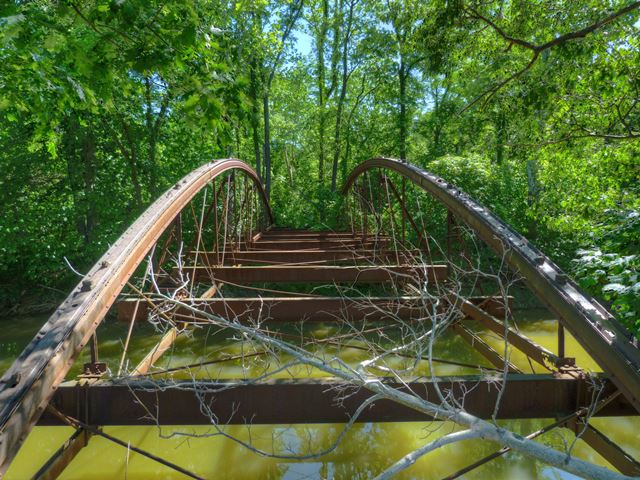We Recommend:
Bach Steel - Experts at historic truss bridge restoration.
BridgeHunter.com Phase 1 is released to the public! - Visit Now
Rocky Fork Bridge

Primary Photographer(s): Nathan Holth and Rick McOmber
Bridge Documented: June 7, 2014
Rural: Highland County, Ohio: United States
By Builder/Contractor: Wrought Iron Bridge Company of Canton, Ohio
Not Available or Not Applicable
75.0 Feet (22.9 Meters)
75.0 Feet (22.9 Meters)
11 Feet (3.35 Meters)
1 Main Span(s)
36XXXX1

View Information About HSR Ratings
Bridge Documentation
This bridge is a classic 1870s cast and wrought iron bowstring truss bridge. 1870s bowstrings are among the rarest and most historic of bridges in the United States, due to their age, unusual (often patented) details associated with their builders, and importance in jump-starting the development of the use of metal in bridge construction.
This particular example is long-abandoned. It deserves so much more than abandonment. It needs to be relocated, restored, and reused somewhere. It would make a functional, signature attraction on any non-motorized trail, or an instant centerpiece and destination attraction for a park.
The truss lines retain excellent historic integrity. The floor beams on the bridge are very old, yet are not original to the bridge. Additional non-original outriggers are also present on the bridge, but the original outriggers remain. Someone relocating the bridge would have the choice of retaining these alterations, or returning the bridge to a more original appearance. The alterations are not particularly significant; either choice would be acceptable.
Information and Findings From Ohio's Historic Bridge InventorySetting/Context The bridge, which is abandoned and has no deck, is located off of a dead-end road in a rural setting. There are cultivated fields to the south of the bridge. The property to the north of the bridge is wooded. Physical Description The 1-span, bowstring truss bridge is approximately 75' long and is 11' wide. It has a tubular arch built-up from channel sections. The lower chords are bars with bolted splices. The verticals alternate between bars with a cross-shaped section (star bars) and built-up, tapered, lattice members. The web diagonals are wrought-iron bars. The rolled floorbeams rest atop the lower chords and are held in place by bolts. The floorbeams are much wider than the bridge and extend beyond the lower chords. At the bearings, the lower chord and upper chord are received by a cast-iron connecting piece. The bridge is supported on concrete abutments. Integrity Extra width of floorbeams is suggestive that this bridge was relocated here and narrowed. The truss lines have excellent integrity of original design. This is a gem. Summary of Significance The bridge is a classic example of the Wrought Iron Bridge Company's patented tubular bowstring truss. It is 1 of 7 identified examples in the Ohio inventory (June 2009). Bowstring trusses are characterized by arched top chords and a trussed or lattice web. They rank among the rarest and most technologically significant of 19th-century metal truss designs since they appeared early in the evolution of iron bridge development and were almost always based on the patents or proprietary designs of bridge builders and engineers. The progenitor of the form was the famed engineer Squire Whipple of New York, who built the first example in 1840 over the Erie Canal at Utica. After the Civil War, Ohio was a center for the development of the bowstring with its concentration of metal bridge-building companies. Companies such Wrought Iron Bridge, Champion Bridge, Massillon Bridge, and King Iron Bridge built their reputations on successful bowstring designs with a dizzying number of variant ways of forming and connecting the truss members. The companies emerged in time to fill the burgeoning demand for an economical, prefabricated bridge for use on American roads. Bowstring trusses thus document this exceptionally inventive and technologically significant period in the development of American metal trusses from the 1860s to early 1880s. The ODOT inventory has identified 22 surviving examples dating from ca. 1864 to 1880 (Phase 1A, 2008). Justification The bridge is one of the 22 extant bowstring truss bridges that survive in the state. Having so many is remarkable, and even though they are "common" based on their numbers, each is an important and irreplaceable record of the development of the metal truss bridge and the ingenuity associated with the Ohio industrial development. The bridge has high significance. Bridge Considered Historic By Survey: Yes |
This bridge is tagged with the following special condition(s): Keystone Columns
![]()
Photo Galleries and Videos: Rocky Fork Bridge
Bridge Photo-Documentation
Original / Full Size PhotosA collection of overview and detail photos. This gallery offers photos in the highest available resolution and file size in a touch-friendly popup viewer.
Alternatively, Browse Without Using Viewer
![]()
Bridge Photo-Documentation
Mobile Optimized PhotosA collection of overview and detail photos. This gallery features data-friendly, fast-loading photos in a touch-friendly popup viewer.
Alternatively, Browse Without Using Viewer
![]()
Maps and Links: Rocky Fork Bridge
Coordinates (Latitude, Longitude):
Search For Additional Bridge Listings:
Bridgehunter.com: View listed bridges within 0.5 miles (0.8 kilometers) of this bridge.
Bridgehunter.com: View listed bridges within 10 miles (16 kilometers) of this bridge.
Additional Maps:
Google Streetview (If Available)
GeoHack (Additional Links and Coordinates)
Apple Maps (Via DuckDuckGo Search)
Apple Maps (Apple devices only)
Android: Open Location In Your Map or GPS App
Flickr Gallery (Find Nearby Photos)
Wikimedia Commons (Find Nearby Photos)
Directions Via Sygic For Android
Directions Via Sygic For iOS and Android Dolphin Browser
USGS National Map (United States Only)
Historical USGS Topo Maps (United States Only)
Historic Aerials (United States Only)
CalTopo Maps (United States Only)

